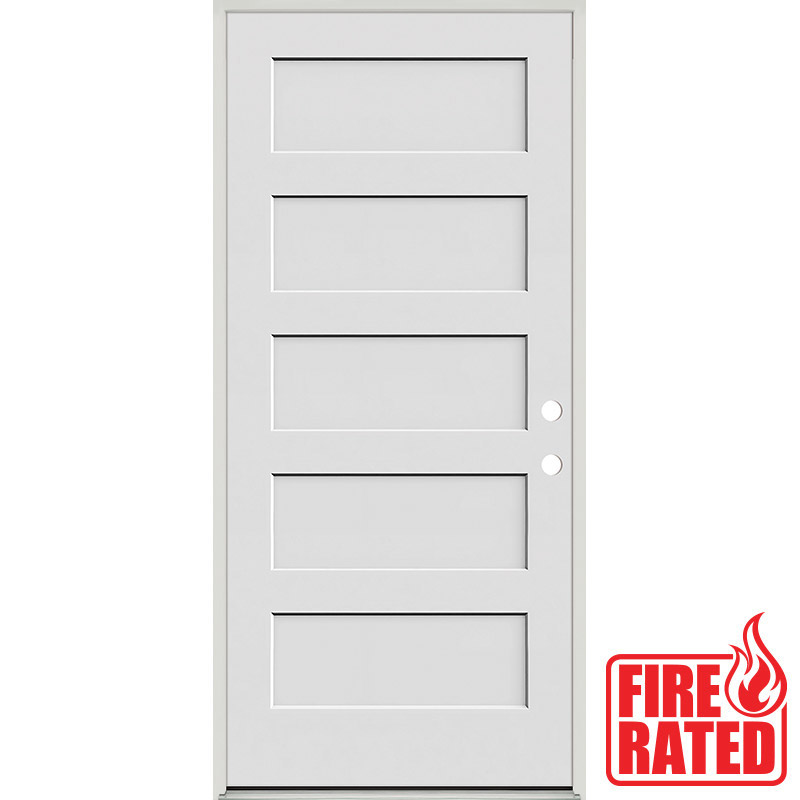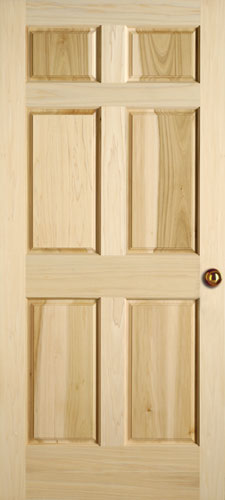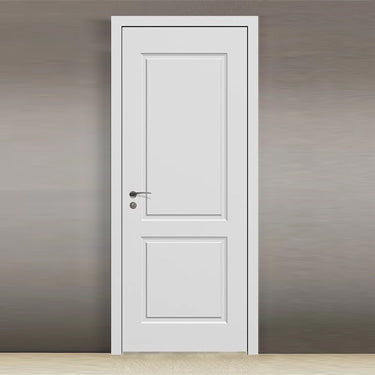Fire rated interior doors are designed to resist fire and smoke for a specific duration. These doors help maintain a building’s compartmentalization during a fire emergency.
Ensuring the safety and integrity of a building during a fire is critical, and fire rated interior doors play a crucial role in this aspect. They are an essential component of a building’s passive fire protection system, designed to compartmentalize and prevent the spread of fire, smoke, and toxic fumes.
This allows occupants more time to evacuate and limits property damage. Constructed with materials like steel, composite, or solid wood cores, these doors must meet regulatory standards and are rated for fire resistance typically ranging from 20 to 90 minutes. Building codes often require the installation of fire rated doors in various parts of a structure, such as between garages and living spaces or in commercial properties, ensuring added protection in critical areas. Incorporating fire rated doors enhances a building’s safety features while also potentially reducing insurance premiums.
Introduction To Fire Rated Interior Doors
Understanding the importance of fire rated interior doors is crucial for anyone interested in building safety. These doors do not just serve as a passage from one room to another. They stand as a protective barrier, shielding you from the dangers of fire and smoke. Let’s explore the essential roles and surprising benefits of these life-saving features in your home or workplace.
Safety First: The Role Of Fire Rated Doors
Fire rated doors are vital in maintaining a secure environment. They are designed to withstand fire for a designated period. These periods, typically ranging from 20 to 90 minutes, give occupants time to evacuate and help prevent the spread of fire. Not only do they increase the safety of a building, but fire rated doors also contribute to the following:
- Compartmentalization: Creating separate fire zones limits fire growth.
- Evacuation support: They offer safe escape routes for people inside.
- Property protection: By hindering fire spread, they minimize damage.
- Emergency access: They provide a path for firefighters to control the blaze.
Aesthetics And Functionality Combined
Fire rated doors blend safety with style gracefully. They come in various materials like wood, steel, or glass, and can match any decor. Modern designs ensure that these doors enhance a room’s aesthetics while offering peace of mind. Benefits include:
| Feature | Description |
|---|---|
| Diverse Styles | Fire doors can complement interior designs. |
| Custom Finishes | Options range from paint to veneer, suiting any taste. |
| Sound Insulation | They can reduce noise, enhancing privacy and comfort. |
| Energy Efficiency | Well-insulated doors can help lower energy costs. |
Material Matters
Material Matters in fire rated interior doors are crucial for safety. The right choice provides peace of mind. It protects property and lives in emergencies. Let’s explore the materials that make doors fire resistant.
Fire Resistant Materials Explained
Fire resistant materials are key for any fire rated door. These materials slow down fire spread. They reduce smoke and heat. Here are common fireproof materials:
- Gypsum: Great at resisting heat.
- Steel: Withstands high temperatures.
- Wood: Can be treated with fire retardants.
- Glass: Special types can resist fire too.
- Vermiculite: Used in cores for added protection.
Comparing Wood, Steel, And Composite Doors
Different materials offer unique benefits. Let’s compare wood, steel, and composite doors.
| Material Type | Advantages | Fire Resistance |
|---|---|---|
| Wood | Warm look, customizable | Good with treatments |
| Steel | Very durable, high security | Excellent |
| Composite | Energy efficient, stable | Varies by mix |
Wood doors are popular for their natural look. They need fire-retardant chemicals. Steel doors offer top-notch safety. They resist fire longer. Composite doors blend materials. They balance beauty and function.
Designing With Safety In Mind
Designing with Safety in Mind encompasses more than sheer functionality; it blends the critical aspects of security with aesthetic appeal. Fire-rated interior doors have evolved, now offering not only protection but also contributing significantly to interior design schemes.
Stylish Features Of Modern Fire Doors
Modern fire doors come with stylish features that defy their utilitarian roots. They boast sleek lines, glass panels, and various finishes:
- Glass Inserts: Allow light to pass through, enhancing ambiance while adhering to safety codes.
- Multiple Finishes: From wood veneer to laminate, choices match any decor.
- Slim Profiles: Modern designs offer slimmer frames for a more sophisticated look.
Customization While Meeting Safety Standards
Choosing a fire door does not mean compromising on design. Customizable options ensure that safety requirements are met without sacrificing style:
| Feature | Customizable Options |
|---|---|
| Size | Exact dimensions for unique spaces |
| Color | A range of hues to fit any palette |
| Hardware | Variety of handles and hinges for unique looks |

Credit: www.doorclearancecenter.com
Technical Specifications
Understanding the technical specifications of fire-rated interior doors is key. It ensures safety and compliance with building regulations. These doors play a vital role in preventing the spread of fire within a building. Let’s explore the core technical aspects of these life-saving features.
Rating Systems And What They Mean
Fire-rated doors come with different time-based ratings. These ratings are crucial to understanding their efficacy in fire containment. The most common ratings are 20, 45, 60, 90, and 120 minutes. These numbers reflect the minimum amount of time the door can withstand a fire while staying intact. Doors with higher ratings provide greater protection.
- 20-minute doors: Suitable for corridors or home divisions.
- 45-minute doors: Often used in exterior apartment doors.
- 60-minute doors: Found in commercial buildings.
- 90-minute doors: Required for stairwells in multi-story buildings.
- 120-minute doors: Used in areas needing maximum fire resistance.
The Importance Of Proper Seals And Insulation
Seals and insulation are critical for the door’s performance during a fire. They prevent smoke and flames from passing through. Properly installed, they ensure the door’s effectiveness. Highlighted below is a list of components contributing to optimal door insulation and sealing:
| Component | Function |
|---|---|
| Intumescent seals | Expand when exposed to heat, sealing gaps. |
| Smoke seals | Block smoke from slipping through door edges. |
| Door sweeps | Cover the gap between the door bottom and floor. |
| Neoprene gaskets | Enhance acoustic and thermal insulation. |
Every fire-rated door must include proper seals and insulation to work as intended. They are part of the door’s core specification. Regular checks and maintenance ensure these components remain in prime condition, offering reliability when most needed.
Installation Insights
Fire Rated Interior Doors ensure safety in every home. Proper installation is key for them to function correctly. Here are crucial insights into getting them installed right.
Professional Vs. Diy Installation
Deciding between professional help or a DIY approach is important. Let’s break it down to make the best choice.
- Expertise: Professionals have training. They know the best practices.
- Tools: They come equipped with the right tools.
- Time: A pro can save you time. DIY might take longer.
- Warranty: Installation by a pro often comes with a service guarantee.
- Risks: DIY means more room for error. Pros minimize risks.
Common Installation Pitfalls To Avoid
To ensure a flawless installation, stay clear of these common mistakes.
| Pitfall | Why Avoid |
|---|---|
| Inaccurate Measurements | Leads to poor fitting doors. |
| Ignoring Instructions | Every door has unique aspects. Instructions are key. |
| Wrong Tools | Can cause damage during installation. |
| Over Tightening Hardware | Can strip screws and weaken the door frame. |

Credit: www.simpsondoor.com
Maintenance And Upkeep
Fire rated interior doors serve as a critical safety feature in every building. These doors resist the spread of fire and smoke. Like every important safety feature, they require regular maintenance. This ensures they function correctly in an emergency. We’ll guide you through routine checks and replacing parts.
Routine Checks for Optimal Performance
Routine Checks For Optimal Performance
Regular inspections ensure fire doors are ready to protect. Look for signs of damage. Check for gaps and seal integrity. Test the closing mechanism. It must shut the door fully. Report issues immediately. Follow this simple checklist for thorough evaluation:
- Examine door and frame for damage or warping.
- Ensure no gaps exceed the thickness of a nickel.
- Test self-closing devices for full and secure door closure.
- Inspect seals for any signs of wear or damage.
Replacing Parts: When and What
Replacing Parts: When And What
Replace parts at signs of damage. Commons parts include seals, hinges, and door closers. Use approved parts for your specific door. Follow the manufacturer’s guidelines. Here’s a quick reference on part replacement:
| Part | Signs of Wear | Action |
|---|---|---|
| Seals | Cracks or visible damage | Replace immediately |
| Hinges | Squeaking or visible wear | Tighten or replace as needed |
| Door Closers | Failure to fully close | Adjust or replace |
Keep records of checks and replacements. Stay proactive in maintenance tasks. This can save lives during a fire.
Legislation And Codes
Legislation and Codes play a critical role in the world of construction, especially concerning fire safety. Interior doors are no exception. Appropriate fire-rated doors are not just recommendations; they are a requirement under various building codes and regulations. Their installation is essential for protecting life and property in the event of a fire. They also significantly influence insurance policies and premiums. Understanding the intricate laws and ensuring compliance can be overwhelming, but it’s a must for safety and legality.
Navigating Building Codes And Regulations
Fire-rated interior doors must meet specific standards set by local and international building codes. These codes ensure that doors can withstand a fire for a certain amount of time, typically ranging from 20 to 90 minutes. Key guidelines include:
- Material standards — doors must be made from materials that resist fire.
- Installation requirements — proper fitting and sealing are crucial.
- Rating labels — doors should have a mark showing their fire rating.
- Regular inspections — to ensure ongoing compliance and safety.
Building regulations might vary based on location, building type, and usage, making compliance a complex task. Specialized codes such as the International Building Code (IBC) often apply to areas like commercial buildings, while residential structures might follow the International Residential Code (IRC). Professional installers and experts can help navigate these regulations to ensure a building is up to code.
Impact Of Compliance On Insurance
Compliance with building codes not only ensures safety but also affects insurance. Insurers consider the level of risk when issuing policies. Non-compliance with fire safety standards may result in:
- Higher insurance premiums due to increased risk.
- Potential denial of claims following a fire incident.
- Possible legal consequences for failing to meet safety regulations.
On the other hand, installing certified fire-rated doors can lead to benefits such as lower insurance premiums because it demonstrates a commitment to safety and risk reduction. Such compliance also ensures that, in the case of a fire, insurance coverage is more likely to be honored, offering peace of mind.
To sum it up, adherence to fire safety legislation and building codes is indispensable not just for legal conformity but also for beneficial insurance outcomes. A proactive approach to installing and maintaining fire-rated doors can save lives and reduce financial burdens in case of an emergency.
Case Studies
Exploring case studies of fire rated interior doors shines light on their critical role in safety. These stories tell of real-life scenarios where such doors have been instrumental in protecting lives and property. Let’s delve into some impactful examples, learning from past incidents and celebrating success stories in design and application.
Real-world Incidents: Lessons Learned
Understanding the gravity of fire incidents prompts the assessment of fire-rated doors in action. We examine cases where these doors stood between safety and catastrophe.
- A hotel fire: Guests escaped unharmed, thanks to compartmentalization achieved by fire-rated doors.
- An office complex: A fire broke out post-business hours; fire doors contained the blaze until firefighters arrived.
- An apartment block: A kitchen fire’s spread got hindered by correctly installed fire-rated doors, saving numerous homes.
Design And Function: Showcase Of Success Stories
Not only do they protect, but fire-rated doors also add aesthetic value to interiors. Here are proven success stories that combine safety with style.
| Project | Details | Outcome |
|---|---|---|
| Luxury Condo | Custom-designed fire-rated doors matching decor | Beauty met safety, increasing property value. |
| Historic Theatre | Vintage-styled fire-rated doors blended with heritage | Theatre’s charm preserved with modern protection. |
| Modern Office | Seamless glass fire-rated doors for open-plan space | Openness without compromising on safety assured. |
Frequently Asked Questions
Can Interior Doors Be Fire Rated?
Yes, interior doors can be fire-rated. They are designed to withstand fire for a specified period, typically ranging from 20 to 90 minutes, to help prevent the spread of fire and smoke.
Which Internal Doors Need To Be Fire Rated?
Fire rated doors are essential for rooms leading to stairwells and corridors in multi-occupancy buildings. Regulations may vary, so check local building codes for specifics.
What Makes A Door 20-minute Fire Rated?
A 20-minute fire-rated door withstands flames and heat for 20 minutes due to its construction materials and thickness. It’s tested and certified to meet specific safety standards.
How Do You Make An Interior Door Fire Rated?
To make an interior door fire-rated, upgrade with fire-resistant materials. Install a solid core door, apply intumescent strips, and use fire-rated hinges. Ensure proper door fitment in the frame for sealing. Comply with local fire safety codes and official fire-rating standards.
Conclusion
Fire rated interior doors are a crucial safety feature for any building. They blend protection with aesthetic appeal, ensuring peace of mind. Remember, choosing the right door impacts both safety and design. Invest wisely and upgrade your space with these life-saving barriers.
Stay safe, stay stylish.

I’m Abdus Sobur, a highly skilled and professional Fire Safety Officer with a passion for safeguarding lives and property. Over the course of my career, I’ve conducted numerous successful fire safety audits, earning a reputation for excellence in ensuring public safety.
In addition to my role as a Fire Safety Officer, I’m also dedicated to raising awareness about the importance of fire safety. Through my blog, I share insights into the functions of different fire safety equipment, aiming to empower individuals with the knowledge they need to protect themselves and their communities.
I’m driven by a deep commitment to promoting fire safety awareness and preventing fire-related incidents.

